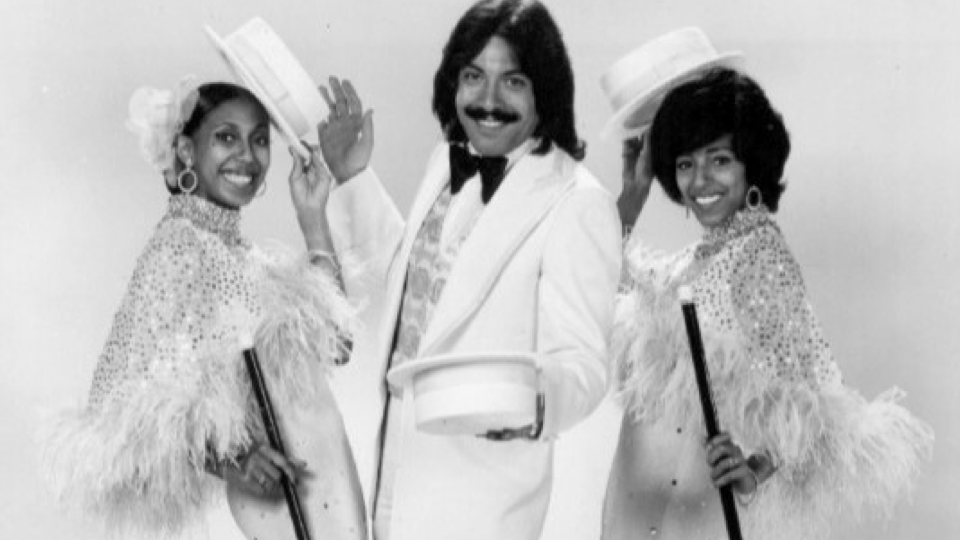Those of us old enough to remember pop music of the early ’70s are likely to have Tony Orlando and Dawn somewhere in our marrow. Their catchy tunes played endlessly on radio during this more innocent time. They’ve since become something of a guilty pleasure (it’s OK, you can admit it).
Frontman Tony Orlando sported an abundant mustache and virtuoso vocals. The band was called “Dawn” because Orlando was an executive for competing Columbia Records at the time, reluctant to put his name on record. (“Dawn” is believed to be the middle name of another executive’s daughter, but details remain murky.)
Their singles began climbing the charts and Orlando’s name got officially billed. The permanent Dawn backup singers were Telma Hopkins and Joyce Vincent, a seasoned duo who rounded out his vocals to perfection. The group became stars and hosted their own TV variety show, filling in the Sonny & Cher-shaped hole that occurred when that show ended. Their smooth, lounge-y vibe may sound dated in a more jaded era, but their songs still feel pretty good to the soul.
“Say, Has Anybody Seen My Sweet Gypsy Rose”
With the release of The Sting in 1973, ragtime music made its way back into the public realm. Tony Orlando seized the musical moment with his 1974 concept album Dawn’s New Ragtime Follies, where current tunes were given a vintage jazzy treatment; it yielded their most successful LP. One standout track was the maudlin yet sprightly “Say, Has Anybody Seen My Sweet Gypsy Rose,” which plays like a tune from the 1930s with a ’70s stylistic overlay. The head-scratching story about a husband wondering why his wife split to dance naked (except for the “rings on her fingers and bells on her toes”) in a New Orleans burlesque show is a terrific novelty song and tuneful time capsule.
“Knock Three Times”
A memorable ode to tenement living and a man’s desire for his downstairs neighbor, Orlando himself was surprised it became a hit. But its appeal was far more universal and it topped the Billboard charts in January 1971. This was proto-Dawn with Toni Wine and Linda November singing with Orlando. “Knock Three Times” is filled with endearing, evocative clanging sounds. “Knock three times on the ceiling if you want me/twice on the pipe/means the answer is no” are lyrics that stick like musical oatmeal to the ribs.
“Who’s In the Strawberry Patch With Sally?”
Another track from “Dawn’s New Ragtime Follies” tackles sexual jealousy with an old-timey treatment. The track has sweetness and swing amidst the implied bitterness of the narrator. Dawn provided delicious back-up in this fun earworm of a tune, which reached #3 on the Billboard charts.
“Candida”
The first single released by Dawn in 1970, it’s the tune that Orlando wanted to sing anonymously due to his strong belief that the song would go nowhere fast. Wrong! This classic love song became a worldwide hit. Orlando was approached to sing it because he could bring an urban, ethnic sensibility to the material. He did just that, singing about an ordinary guy wanting to take his beloved Candida out of the gritty city and bring her “the further from here, girl, the better/where the air is fresh and clean.” The song touched listeners so profoundly that (despite its alternate definition as a fungal infection) there was an uptick in babies named “Candida” at the time.
“Tie a Yellow Ribbon Round the Ole Oak Tree”
One of the most deeply affecting pop tunes of the era (and, in fact, the top-selling single of 1973) is this enormous hit from their Tuneweaving album. “Tie a Yellow Ribbon” has a next-level lilt and sing-along vibes. It’s the story of a man returning from prison after three years, praying on the bus that he will be welcomed by the woman he left behind. He fervently hopes that the visual of a yellow ribbon will be waiting for him but accepts either outcome by saying that if there isn’t one, he will “stay on the bus, forget about us, put the blame on me.” The besotted narrator gets his wish, and one of pop music’s happiest lyrics is “Now the whole damn bus is cheering/and I can’t believe I see/a hundred yellow ribbons round the ole oak tree.” It has become a classic tune honoring soldiers returning from war and remains an ode to personal accountability, redemption, and love.
-Ellen Fagan
Photo: Tony Orlando and Dawn (1974) (Public Domain)





I’m guilty as charged. Now I’ll have those songs in my head all day. Lol
Yay!! Happy to hear it. You & me both!
Guilty as well! But Tony’s early sixties teen idol hits (“Bless You,” “Halfway to Paradise”) are just as addictive!
Absolutely, Thomas! He was a smooth teen idol for sure. What a career!
You know that “Rings on her Fingers Bells on her Toes” line came from the much earlier “I’ve Got Rings On My Fingers (Bells On My Toes)” by Blanche Ring way back in 1909. Blanche maybe was the Tony Orlando of her day. Great article!
Thanks so much, Ross!! That is a fabulous piece of intel. Time to check out Blanche Ring! 🙂